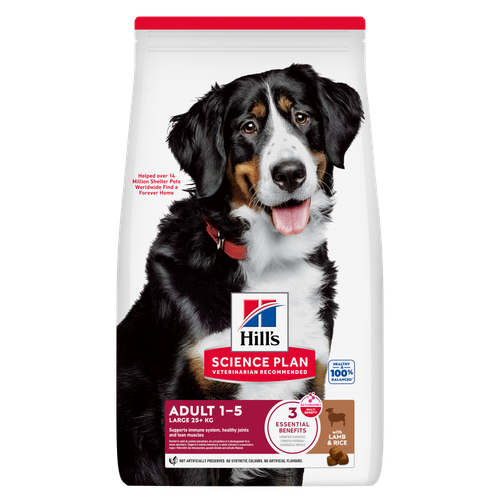
-
Find the right food for your petTake this quiz to see which food may be the best for your furry friend.Find the right food for your petTake this quiz to see which food may be the best for your furry friend.Featured products
 Large Breed Adult Dog Food
Large Breed Adult Dog FoodHill's Science Plan Large Breed Adult Dog Food with Lamb & Rice is a complete pet food, specially formulated with ActivBiome+ Multi-Benefit Technology.
This food is specifically designed to fuel the energy needs of large breed dogs during the prime of their life.Shop Now Perfect Digestion Large Breed Puppy Food
Perfect Digestion Large Breed Puppy FoodPrecisely balanced nutrition with Hill's ActivBiome+ prebiotic blend actively contributes to supporting digestive health and overall wellbeing to help your pet feel their best
Shop Now Adult Light Dog Food
Adult Light Dog FoodHill's Science Plan Light Adult Wet Dog Food is a complete premium pet food for adult dogs that tend to gain weight easily. This deliciously smooth loaf is formulated to deliver the appropriate amount of energy to support weight maintenance in adult dogs.
Shop NowFeatured products Adult Cat Food
Adult Cat FoodHill's Science Plan Adult Cat Food with Chicken is a complete pet food, specially formulated with ActivBiome+ Multi-Benefit Technology.
This food is specially formulated to fuel the energy needs of cats during the prime of their life.Shop Now CULINARY CREATIONS ADULT CAT FOOD
CULINARY CREATIONS ADULT CAT FOODHill's Science Plan CULINARY CREATIONS Adult cat food with Salmon & Carrots was formulated to provide a great-tasting experience to cats. Its delicious flavour and texture are combine with essential nutrients to support cats' optimal health during the prime time of their life. Specially formulated with high-quality salmon protein, essential taurine for heart health & balanced minerals to support kidneys & bladder.
Shop Now Sterilised Adult Cat Food
Sterilised Adult Cat FoodHill's Science Plan Adult Sterilised Cat Dry Food with Salmon is specially formulated with ActivBiome+ Multi-Benefit Technology. It is a precisely balanced nutrition, tailored to meet the needs of sterilised cats, to help keep sthem lean & healthy.
Shop Now -
Dog
- Dog Tips & Articles
-
Health Category
- Weight
- Food & Environmental Sensitivities
- Urinary
- Digestive
- Joint
- Kidney
-
Life Stage
- Puppy Nutrition
- Adult Nutrition
- Senior Nutrition
Cat- Cat Tips & Articles
-
Health Category
- Weight
- Skin & Food Sensitivities
- Urinary
- Digestive
- Kidney
-
Life Stage
- Kitten Nutrition
- Adult Nutrition
Featured articles The Incredible Science Behind Your Pet's Microbiome
The Incredible Science Behind Your Pet's MicrobiomeLearn what your pet's microbiome is, how it contributes to your pet's gut and overall health, and why nutrition is important in maintaining healthy microbiomes.
Read More Pet Nutrition: What Makes "Healthy" Pet Food Healthy? | Hill's Pet
Pet Nutrition: What Makes "Healthy" Pet Food Healthy? | Hill's PetIn people, the right diet is very important. If you are eating the wrong way for your metabolism, activity level, age and lifestyle you could end up with health issues.
Read More Microchipping: The Facts | Hill's Pet
Microchipping: The Facts | Hill's PetThe government has announced that as of April 2016, all dogs in the UK must be microchipped by law.
Read More -


Your cat’s paws are as important to them as your hands and feet are to you. As a cat parent, it's important to help your cat maintain healthy paws. This quick guide to cat paw care will help you keep your furry friend’s paw pads healthy and clean.
Why Care for Cat Paw Pads?

Think for a moment about how cats use their paws. They walk across a variety of surfaces in your house, including dirty surfaces such as the litter box. If they're allowed outside, they may walk across rough and rocky ground, step on thorns and other sharp items, and tread across hot or cold surfaces, depending on the weather. Cats allowed outdoors in the winter are also susceptible to walking through harsh salts and other de-icing agents that can be harmful to paws.
At some point in the day, your cat will take it upon themselves to clean their own paws by licking them, possibly ingesting any harmful substances their little paws may have picked up in the process. Regular cat paw care that includes inspections and cleaning will not only help keep your cat’s paws clean and safe for licking, but also allow you to manage dry and cracked paws, cuts and other injuries before they can become infected.


Tasty Tips
Cat Paw Care Guide
Getting Started
While inspecting your cat's paws on a regular basis will be good for ensuring you keep them healthy, you can also look for signs that something may be going on with the paws. If you notice your cat is limping or not putting pressure on a certain paw, they might have something stuck in it or could have injured their paw in some manner. Keep in mind that cats are good at hiding their pain, so you may have to pay close attention. Additionally, when a cat is injured they might be less receptive to you inspecting them, so do your best to keep them comfortable and calm while you inspect them.
If your cat isn't used to having their paws handled, you may need to get them accustomed to the idea. It can be helpful to get into the habit of massaging your cat’s paws when you hold or pet them, from an early age onwards. This will not only help them become accustomed to having their paws touched and handled, but will also help you detect any debris that might be caught between the toes and paw pads.
Paw Inspection
Once your cat tolerates you handling their paws, make it a point to examine them daily, especially after they return from an outdoor journey. Look for scratches, sores, and foreign objects. If you find something embedded in your cat’s paw, try using a pair of tweezers to gently remove it. If it’s deeply embedded, call your veterinarian.
Paw Cleaning
Either before or after your inspection, use a soft cloth to wipe all those tiny cat paw pads, as well as around the pads and between the toes. This will clear their toes of dirt, litter dust and any chemicals or foreign objects.
Nail Trimming

Use a pair of nail scissors or clippers to trim your cat’s claws. The PDSA recommends using a set of scissors or clippers specifically designed for cat claws, as human nail clippers can cause your cat’s nails to split.
Be sure to trim just the tips, taking care to avoid the quick (the part of the nail containing sensitive nerves and veins). If you do accidentally cut into the quick, use some styptic powder to stop the bleeding. If you don't have any styptic powder on hand, it may be a good idea to buy some at your local pet supply store just in case you need it.
Treating Dry Cat Paw Pads
If your cat’s paw pads become dry, irritated or cracked, contact your vet; they may recommend that you try moisturising them with olive, coconut or another food-quality oil that will be safe for them to lick. You may want to confine them to a bathroom while the oil absorbs to keep them from tracking it through the house. If they need something more heavy-duty, ask your vet to recommend a good paw moisturiser for cats. Avoid lotions made for humans or other animals, which may be harmful if ingested.
Additional Considerations
Of course, one of the best things you can do for your cat's paws is to keep them indoors, where they’ll be less likely to become injured or encounter extremely hot or cold surfaces or dangerous chemicals. Dry winter air can dry out your cat’s paws, so consider using a humidifier during cold months. A scratching post can also help keep their nails in good condition, not to mention keeping your carpet and furniture safe from the urge to claw.
With everything involved in caring for cats, it's easy to overlook proper cat paw care. Making a daily habit of checking and cleaning their paws will make it easy to keep them in good shape.


Jean Marie Bauhaus is a pet parent, pet blogger, and novelist from Tulsa, Oklahoma, where she usually writes under the supervision of a lapful of fur babies.
Related products

Hill's Science Plan Adult Sterilised Cat Dry Food with Salmon is specially formulated with ActivBiome+ Multi-Benefit Technology. It is a precisely balanced nutrition, tailored to meet the needs of sterilised cats, to help keep sthem lean & healthy.

Hill's Science Plan Senior Vitality Cat Food with Chicken & Rice provides precisely balanced nutrition that helps promote their everyday ability to get up and go.

Hill's Science Plan Adult Cat Food with Chicken is a complete pet food, specially formulated with ActivBiome+ Multi-Benefit Technology.
This food is specially formulated to fuel the energy needs of cats during the prime of their life.

Hill's Science Plan CULINARY CREATIONS Adult cat food with Salmon & Carrots was formulated to provide a great-tasting experience to cats. Its delicious flavour and texture are combine with essential nutrients to support cats' optimal health during the prime time of their life. Specially formulated with high-quality salmon protein, essential taurine for heart health & balanced minerals to support kidneys & bladder.
Related articles

Understand common skin issues in cats and how to manage them effectively. Learn signs and prevention, and get care tips. Find out more at Hill's Pet.

Learn how your cat's poo can be a good indicator of her overall health, including how to spot unhealthy or abnormal cat poop and what it might mean.

Cats with sensitive skin have special needs and even healthy cats can sometimes develop poor skin health. Learn more about sensitive skin symptoms in your cat, what you can do to help your pet feel more comfortable and get recommendations on sensitive skin cat food.

Learn about the causes of cat dermatitis, how to spot the symptoms and the best treatment options. Visit Hill's Pet for detailed guidance and tips.

Put your cat on a diet without them knowing
Our low calorie formula helps you control your cat's weight. It's packed with high-quality protein for building lean muscles, and made with purposeful ingredients for a flavourful, nutritious meal. Clinically proven antioxidants, Vitamin C+E, help promote a healthy immune system.
Put your cat on a diet without them knowing
Our low calorie formula helps you control your cat's weight. It's packed with high-quality protein for building lean muscles, and made with purposeful ingredients for a flavourful, nutritious meal. Clinically proven antioxidants, Vitamin C+E, help promote a healthy immune system.

